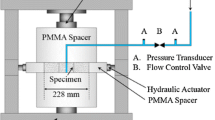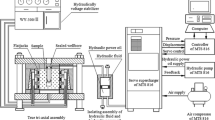Abstract
Fractures in geomaterials e.g., hydraulic fractures often contain bridges—parts of unbroken material connecting the opposite faces of the fracture distributed over the fracture and constricting its opening. Our laboratory experiments demonstrate that the bridges can even hold the sample cut through by a fracture together, in one piece. We model such a fracture as a crack with Winkler layer whose stiffness is controlled by the bridge geometry and distribution. The model shows that short constricted fractures are insignificantly different from the conventional cracks; only large fractures, i.e. the fractures whose size is of the order of the characteristic scale of the bridge constriction are affected. The constricted fractures have the opening and the Mode I stress intensity factor bound as the fracture dimensions proportionally increase, which distinguish them from the conventional cracks where both the opening and the stress intensity factors tend to infinity as the crack size increases.
Access this chapter
Tax calculation will be finalised at checkout
Purchases are for personal use only
Similar content being viewed by others
References
van Dam, D.B., de Pater, C.J.: Roughness of hydraulic fractures: The importance of in-situ stress and tip processes. SPE Annual Technical Conference and Exhibition. Society of Petroleum Engineers (1999). doi:10.2118/56596-MS
Swanson, P.L., Fairbanks, C.J., Lawn, B.R., Mai, Y.-W., Hockey, B.J.: Crack-interface grain bridging as a fracture resistance I, mechanism in ceramics: I. Experimental study on alumina. J. Am. Ceramic Soc. 70(4), 279–289 (1987)
Hu, X., Wittmann, F.H.: An analytical method to determine the bridging stress transferred within the fracture process zone: I. General theory. Cement Concr. Res. 21(6), 1118–1128 (1991)
Hallam, S.D., Last, N.C.: Geometry of hydraulic fractures from modestly deviated wellbores. J. Petrol. Technol. 43, 742–748 (1991)
Li, Q., Xing, H., Liu, J., Liu, X.: A review on hydraulic fracturing of unconventional reservoir. Petroleum 1, 8–15 (2015)
Dyskin, A.V., Pasternak, E., He, J., Lebedev, M., Gurevich, B.: The role of bridge cracks in hydraulic fracturing. In: Kotousov, A., Ma, J. (eds.) Proceedings of the 10th International Conference on Structural Integrity and Failure (SIF2016), Adelaide, Australia, Paper #6 (2016)
Tedesco, J.W., McDougal, W.G., Ross, C.A.: Structural Dynamics: Theory and Applications. Pearson (1988)
Mockovčiaková, A., Pandula, B.: Study of the relation between the static and dynamic moduli of rocks. Metalurgija 42(1), 37–39 (2003)
Shifrin, E.I.: The I-Mode crack whose sides interact according to a linear law. Mech. Solids 23(5), 91–97 (1988)
Green, A.E., Sneddon, I.N.: The distribution of stress in the neighbourhood of a flat elliptical crack in an elastic solid. In: Mathematical Proceedings of the Cambridge Philosophical Society, vol. 46, pp. 159–163 (1950)
Acknowledgements
We acknowledge the financial support from the Australian Research Council linkage project LP 120200797, Australian Worldwide Exploration (AWE) limited and Norwest Energy NL Companies. Assistance of Tim Sercombe (UWA) with setting up the tensile tests is greatly appreciated. Discussion with Andy Bunger from University of Pittsburgh is acknowledged. AD and EP acknowledge support from the UWA Near Miss Scheme.
Author information
Authors and Affiliations
Corresponding author
Editor information
Editors and Affiliations
Rights and permissions
Copyright information
© 2017 Springer International Publishing AG
About this paper
Cite this paper
He, J., Pasternak, E., Dyskin, A., Lebedev, M., Gurevich, B. (2017). The Effect of Constriction in Hydraulic Fracturing. In: Papamichos, E., Papanastasiou, P., Pasternak, E., Dyskin, A. (eds) Bifurcation and Degradation of Geomaterials with Engineering Applications. IWBDG 2017. Springer Series in Geomechanics and Geoengineering. Springer, Cham. https://doi.org/10.1007/978-3-319-56397-8_77
Download citation
DOI: https://doi.org/10.1007/978-3-319-56397-8_77
Published:
Publisher Name: Springer, Cham
Print ISBN: 978-3-319-56396-1
Online ISBN: 978-3-319-56397-8
eBook Packages: EngineeringEngineering (R0)




